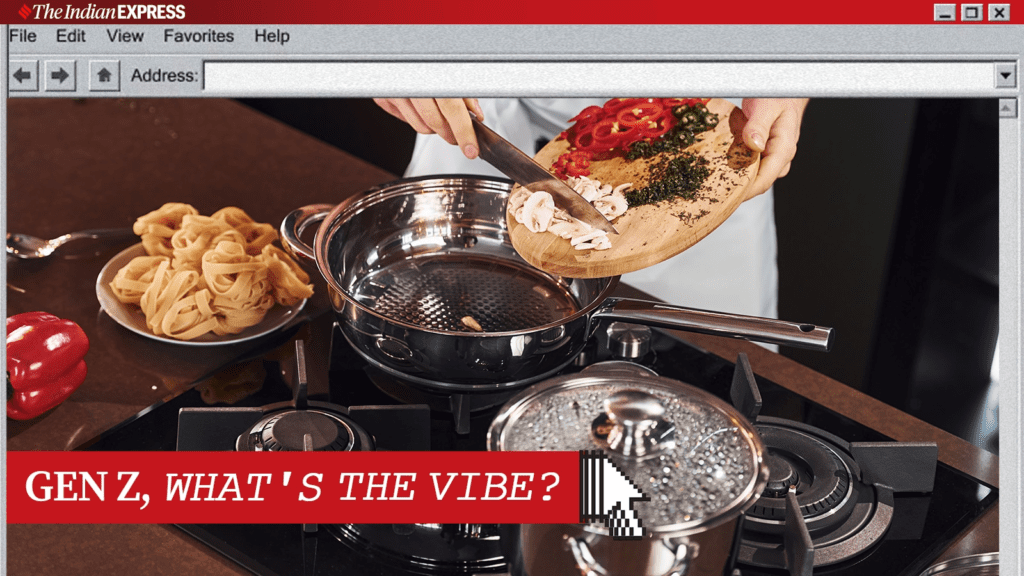As I made my way through the bustling markets of Chandni Chowk, what caught my attention was a gleaming display of steel utensils — in designs I had never imagined. The steel crockery I’ve used for the past 28 years has always carried a signature simplicity. This collection, though, spoke fluent Gen Z — the kind of aesthetic my Instagram feed would approve of. What was once a staple of the older generation suddenly seemed like the latest trend.
“The current trend in the market is steel only,” said Ankit Jain, proud owner of a 50-year-old utensil shop in Sadar Bazar, while showing off his collection. He revealed that people are now ditching plastic, melamine, and aluminium in favour of steel.
“Young logon mein zyada craze hai. Woh samajhdar hain aur phir uska prachar bhi hai. Doctors bhi advice yahi karte hain,” added Subhash Jain of Madras Metal. The 75-year-old trader seemed certain that Gen Z’s increasing focus on health is driving the change.
According to the traders, the shift is relatively recent, with sales booming in the last three to five years across both wholesale and retail. “In the past five years, demand for steel has surged, especially for tri-ply cookware. Big brands like Hawkins, Prestige, and Tramontina have all seen sales increase. Stainless steel cutlery, kadhais, utensils, and strainers are selling rapidly,” said Amit Jain, a utensil trader from Vivek Vihar. “Good-quality steel doesn’t react with food, is easy to clean, and is environmentally friendly.”
Some believe this rise is also tied to growing awareness of the health risks associated with aluminium. “Our cookers are all steel now. Aluminium sales have dropped to zero. Many companies that used to make aluminium products have switched to steel,” said Amit Gupta, another Vivek Vihar shopkeeper (Prime Collection).
Is steel truly the good Samaritan?
“Health comes first! I only eat in steel. Plus, I hate the foul smell that comes with plastic utensils over time,” said 26-year-old Gurveen Kaur. She isn’t alone. Gen Z’s growing health consciousness has made steel a preferred choice.
Senior nutritionist Ashlesha Joshi explains why. “Unlike materials such as un-anodised aluminium, uncast iron, or copper (especially with acidic foods), steel doesn’t typically leach large amounts of reactive metallic ions under normal conditions,” she said.
Story continues below this ad
Steel also resists corrosion, scratching, warping, and flaking under high heat. “This means the cooked food retains its nutrient profile more reliably,” Joshi added, noting this as a key reason behind the generational shift.
Still, some remain cautious. “It’s the least dangerous option,” said 24-year-old yoga instructor Dev Verma. “Kuch na kuch chemical usme bhi hota hai. I try to eat in mitti ke bartan (earthen pots), but that’s not always feasible.” His concern is not unfounded — studies suggest that under certain conditions, steel can leach nickel and chromium into food.
Joshi clarifies, however, that “for most consumers, the leached amounts from stainless steel cookware do not exceed safe intake levels.” Only people with nickel allergies or those who cook very acidic foods for long durations in low-grade pans may face higher exposure, she added.
 According to the traders, the shift is relatively recent, with sales booming in the last three to five years across both wholesale and retail.
According to the traders, the shift is relatively recent, with sales booming in the last three to five years across both wholesale and retail.
Gen Z’s new economic investment
For many, it’s not just about health. “Steel is also economical,” said Mukesh Jain of Bishan Chand Jain and Sons. “Earlier, glass replaced steel, but because of its fragility and rising costs, people are returning to stainless steel. Demand has increased tremendously.”
Story continues below this ad
Subhash Jain agrees. “Crockery is fashionable, but if one plate breaks, the whole set is ruined,” he said. Steel, by contrast, lasts longer and has even become a popular gifting choice.
The durability and ease of maintenance also make steel a hit among students and young professionals. “I have to do everything myself — with steel, I don’t have to worry about anything breaking,” said Shreshth Mishra, an art student in Lucknow. “Even though many hostel students have fancy, Instagram-friendly crockery, steel just makes life easier.”
The ideal way to use steel
Joshi recommends a few precautions for optimal use of stainless steel:
Choose quality steel: Go for high-grade stainless (18/10, 304, or 316) for better corrosion resistance and minimal leaching.
Story continues below this ad
Break in gently: Use new pans for short cooking sessions before making long stews or sauces.
Mind acidity: For prolonged acidic cooking (tomato- or citrus-based dishes), switch to glass or ceramic cookware, or use high-grade, well-maintained steel.
Maintain well: Avoid scratches or corrosion; replace damaged cookware.
Nickel sensitivity: If allergic, opt for glass, ceramic, or cast iron, or choose ultra-low-nickel steel.
Mix materials: Use different cookware for different needs to balance exposure.
Story continues below this ad
Keep balance: Cookware exposure is minor compared to diet, water, and environment — eat a varied diet, stay hydrated, and limit highly processed foods.


